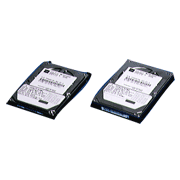The MK1814GAV was a 12.5-millimeter-profile, 2.5-inch magnetic disk unit with a storage capacity of 18.1 GB, the largest capacity in its class. Mass production of the unit began in 1999.
Computers at the time required more and more memory for operating systems and applications and were handling greater volumes of ever-diversifying data — numerical data, images, graphics, and video. As a result, magnetic disk units for notebooks were expected to be thin, consume very little power, provide large amounts of storage, and be highly resistant to impacts. To meet these demands, the MK1814GAV used a loading/unloading mechanism for its GMR head to improve the unit’s impact resistance when not in operation as well as increase its recording capacity.
In the same year, Toshiba also started mass production of the 12.0 GB MK1214GAP, with a 9.5-millimeter profile, the 6.4 GB MK6414MAP, and the 6.0 GB MK6014MAP. All models used the technology developed for the MK1814GAV, which gave a recording density per square inch of between 10.8 and 11.6 GB. The MK6414MAP unit, which provided 6.4 GB of storage on a single disk, featured the world’s highest recording density at the time of 11.6 GB per square inch.
| Model name | MK1814GAP | MK1214GAP | MK6414MAP | MK6014MAP |
|---|---|---|---|---|
| Storage capacity | 18.1GB | 12.0GB | 6.4GB | 6.0GB |
| Average seek time | 13ms | |||
| Data transfer speed | 66.6MB/秒(Ultra DMA/66) | |||
| Rotational speed | 4,200rpm | |||
| Buffer size | 1,024KB | |||
| Interface | ATA-4 | |||
| External dimensions [mm] | 70 x 100 x 12.5 (w x d x h) | 70 x 100 x 9.5 (w x d x h) | ||
| Weight | 138 grams | 99 grams | ||
| Energy consumption efficiency (according to the Energy Conservation Law) |
0.039W/GB (Category E) |
0.054W/GB (Category E) |
0.102W/GB (Category D) |
0.108W/GB (Category D) |
| Impact resistance when not in operation (half sine-wave impact) |
5,880m/s2(600G) (2ms) |
6,860m/s2(700G) (1ms) |
||


